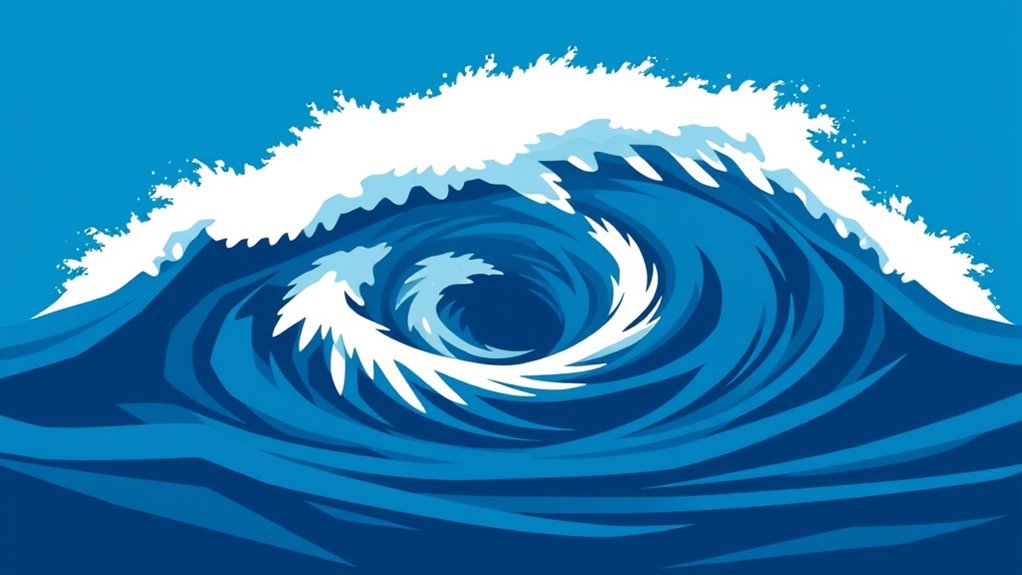Rising ocean temperatures greatly affect squall activity, leading to increased frequency and intensity. Warmer waters improve evaporation, boosting humidity and creating atmospheric instability. This results in stronger winds and heavier precipitation during squalls. Historical trends highlight a notable uptick in squall events, particularly in tropical regions. The unpredictability of these storms poses risks to coastal communities and maritime operations. Exploring this relationship further reveals the broader consequences for climate change and weather patterns.
Main Points
- Warmer ocean temperatures increase evaporation, leading to higher humidity and the potential for more intense squall formation.
- Rising sea surface temperatures provide additional energy, contributing to stronger and more frequent squalls.
- Satellite data and climate models show a direct correlation between warmer waters and increased squall intensity and frequency.
- Historical trends indicate a notable rise in squall events in tropical and subtropical regions due to changing ocean temperatures.
- Increased squall activity poses significant risks to coastal communities, maritime operations, and infrastructure, necessitating enhanced forecasting and resilience strategies.
Understanding Squalls: Characteristics and Impacts
Although squalls are often brief and localized, their features and impacts can be considerable. These sudden, intense bursts of wind and precipitation can develop rapidly, leading to notable changes in weather conditions over a short period. Typically marked by strong winds, heavy rain, and reduced visibility, squalls can occur during various weather systems, often associated with cold fronts or thunderstorms.
The impacts of squalls can be substantial, particularly in maritime environments where they pose risks to vessels. The abrupt wind shifts can lead to dangerous sailing conditions, while the heavy rainfall can result in flash flooding on land.
Additionally, squalls may disrupt outdoor activities and damage infrastructure, as their intensity can catch individuals and communities off guard. Understanding the features and potential consequences of squalls is essential for effective weather forecasting and preparedness, ensuring that those affected can respond appropriately to these sudden weather events.
The Role of Ocean Temperatures in Weather Patterns

Ocean temperatures greatly influence weather patterns, including the formation and intensity of squalls. The warmth of ocean waters serves as a crucial energy source for atmospheric conditions. When sea temperatures rise, they can improve evaporation rates, contributing to increased humidity in the atmosphere. This added moisture is essential for the development of clouds and precipitation, fundamental components of squall formation.
Moreover, warmer oceans can alter atmospheric pressure systems, impacting wind patterns that drive weather phenomena. The interaction between warm and cooler air masses can create instability, leading to the rapid development of squalls.
Additionally, variations in ocean temperature can modify ocean currents, which in turn affect regional climates. Ultimately, ocean temperatures play an important role in shaping weather patterns, demonstrating a complex interplay between marine environments and atmospheric dynamics, crucial for understanding squall activity and broader weather systems.
Scientific Evidence Linking Warmer Waters to Increased Squall Activity
As researchers investigate the relationship between rising ocean temperatures and squall activity, compelling evidence has emerged to support this connection.
Studies indicate that warmer sea surface temperatures provide increased energy for storm development, which can intensify squall formation. Satellite data reveal that regions experiencing heightened ocean temperatures often coincide with heightened squall occurrences, particularly in tropical and subtropical zones.
Furthermore, climate models predict that as ocean temperatures continue to rise, squall intensity and frequency may also increase due to improved convection processes.
In addition, field observations demonstrate that squalls originating over warmer waters exhibit stronger wind patterns and greater precipitation rates.
Historical Trends in Squall Frequency and Intensity

While examining historical trends, researchers have noted a remarkable increase in both the frequency and intensity of squalls over the past few decades. Data from various meteorological records indicate that squall events have become more prevalent, particularly in tropical and subtropical regions. This rise correlates with observed changes in ocean temperatures, which have also shown a consistent upward trend.
Analyses reveal that not only are squalls occurring more often, but they are also exhibiting stronger wind speeds and more vigorous rainfall. This increase in intensity may lead to heightened risks of severe weather-related impacts, including flooding and property damage.
Furthermore, seasonal patterns of squall activity have shifted, with some regions experiencing more frequent occurrences during historically quieter months.
These historical trends suggest a considerable alteration in squall behavior, raising concerns among climate scientists regarding the consequences for future weather systems and their relationships with ongoing climate change.
Case Studies: Recent Squall Events and Climate Change Connections
Recent squall events have underscored the growing connection between climate change and extreme weather phenomena. In 2022, a notable squall swept through the southeastern United States, resulting in wind gusts exceeding 70 mph and widespread damage. Meteorological analyses indicated that the heightened ocean temperatures contributed to the storm's rapid intensification.
Similarly, a squall that struck the Caribbean in 2023 highlighted the role of warmer waters in fueling atmospheric instability, leading to severe thunderstorms and heavy rainfall. Research has shown that rising sea surface temperatures are linked to increased moisture availability, which can exacerbate squall conditions.
In addition, a case study of an October 2021 squall in the North Atlantic revealed a correlation between warmer ocean temperatures and an uptick in the frequency of squall occurrences. These case studies illustrate a concerning trend, suggesting that as climate change progresses, the intensity and frequency of squall events may continue to rise.
Implications for Coastal Communities and Maritime Operations
The increasing frequency and intensity of squall events driven by rising ocean temperatures pose considerable challenges for coastal communities and maritime operations. Coastal areas face heightened risks of flooding, erosion, and damage to infrastructure, affecting local economies reliant on tourism and fishing.
The unpredictability of squalls complicates navigation for vessels, increasing the likelihood of maritime accidents. Shipping routes may also be disrupted, leading to delays in the supply chain.
Additionally, the safety of small craft and recreational boating is compromised as sudden squalls can arise with little warning. Emergency response systems need to modify to these changing conditions, requiring improved forecasting and communication strategies.
Coastal communities must invest in resilience measures, such as reinforced infrastructure and strategic planning, to mitigate the effects of these severe weather events. In the end, the consequences of rising ocean temperatures extend beyond environmental concerns, impacting livelihoods and safety in coastal regions.
Future Research Directions and Mitigation Strategies
As rising ocean temperatures continue to influence squall activity, targeted research initiatives are essential for understanding the underlying mechanisms and developing effective mitigation strategies. Future studies should focus on the correlation between ocean temperature anomalies and squall intensity, utilizing advanced modeling techniques to predict changes in squall frequency and behavior.
Research must also investigate the role of atmospheric conditions, such as wind patterns and humidity levels, in exacerbating squall events.
Mitigation strategies should prioritize coastal infrastructure resilience, incorporating flexible designs to withstand increased squall impacts. Policymakers must collaborate with scientists to implement early warning systems that utilize real-time data, enhancing community preparedness.
Moreover, promoting sustainable practices to combat climate change will be vital in stabilizing ocean temperatures and reducing the severity of squalls. Interdisciplinary approaches that integrate meteorological, ecological, and social sciences will provide thorough observations and encourage effective responses to this evolving challenge.
Common Questions
How Do Squalls Differ From Other Storm Types?
Squalls are brief, intense storms defined by sudden wind shifts and heavy rainfall. Unlike other storm types, they develop rapidly, last for a short duration, and often occur in warm weather, enhancing their unpredictability.
What Are the Warning Signs of an Approaching Squall?
Warning signs of an approaching squall include sudden temperature drops, rapidly darkening skies, increased wind speed, and distant thunder. Observing these changes helps individuals prepare for the intense weather conditions that may soon follow.
How Can Squalls Affect Marine Life?
Squalls can greatly impact marine life by altering water temperature, salinity, and nutrient distribution. These changes may affect fish behavior, disrupt feeding patterns, and lead to shifts in predator-prey dynamics within affected ecosystems.
What Role Do Human Activities Play in Ocean Temperature Rise?
Human activities considerably contribute to ocean temperature rise through greenhouse gas emissions, deforestation, and industrial processes. These actions increase atmospheric CO2 levels, leading to global warming, which subsequently affects marine ecosystems and weather patterns.
Are There Any Long-Term Solutions to Mitigate Squall Impacts?
Experts suggest that long-term solutions to mitigate squall impacts include enhancing coastal infrastructure, improving early warning systems, restoring natural ecosystems, and implementing sustainable land-use practices, aiming to reduce vulnerability and improve resilience in affected regions.

